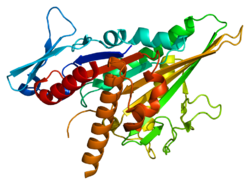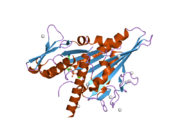| KIFC3 |
|---|
 |
| Available structures |
|---|
| PDB | Ortholog search: PDBe RCSB |
|---|
|
|
| Identifiers |
|---|
| Aliases | KIFC3, kinesin family member C3 |
|---|
| External IDs | OMIM: 604535; MGI: 109202; HomoloGene: 124421; GeneCards: KIFC3; OMA:KIFC3 - orthologs |
|---|
| Gene location (Human) |
|---|
 | | Chr. | Chromosome 16 (human)[1] |
|---|
| | Band | 16q21 | Start | 57,758,217 bp[1] |
|---|
| End | 57,863,053 bp[1] |
|---|
|
| Gene location (Mouse) |
|---|
 | | Chr. | Chromosome 8 (mouse)[2] |
|---|
| | Band | 8 C5|8 47.12 cM | Start | 95,826,456 bp[2] |
|---|
| End | 95,929,440 bp[2] |
|---|
|
| RNA expression pattern |
|---|
| Bgee | | Human | Mouse (ortholog) |
|---|
| Top expressed in | - right lobe of thyroid gland
- left lobe of thyroid gland
- sural nerve
- body of pancreas
- right lobe of liver
- upper lobe of left lung
- skin of abdomen
- right lung
- renal medulla
- left ventricle
|
| | Top expressed in | - right ventricle
- lip
- spermatocyte
- spermatid
- molar
- islet of Langerhans
- morula
- myocardium of ventricle
- adrenal gland
- yolk sac
|
| | More reference expression data |
|
|---|
| BioGPS |  | | More reference expression data |
|
|---|
|
| Gene ontology |
|---|
| Molecular function | - microtubule motor activity
- nucleotide binding
- microtubule binding
- minus-end-directed microtubule motor activity
- ATPase activity
- protein binding
- ATP binding
| | Cellular component | - cytoplasm
- centrosome
- Golgi apparatus
- membrane
- adherens junction
- microtubule organizing center
- cell junction
- zonula adherens
- microtubule
- extracellular exosome
- cytoplasmic vesicle membrane
- cytoskeleton
- cytoplasmic vesicle
- kinesin complex
| | Biological process | - Golgi organization
- epithelial cell-cell adhesion
- microtubule-based movement
- zonula adherens maintenance
- microtubule-based process
- visual perception
| | Sources:Amigo / QuickGO |
|
| Orthologs |
|---|
| Species | Human | Mouse |
|---|
| Entrez | | |
|---|
| Ensembl | | |
|---|
| UniProt | | |
|---|
| RefSeq (mRNA) | NM_001130099
NM_001130100
NM_005550
NM_001318710
NM_001318711
|
|---|
NM_001318712
NM_001318713
NM_001318714
NM_001318715 |
| NM_001145831
NM_001145832
NM_010631
NM_001372312
NM_001372313
|
|---|
NM_001372314
NM_001372315
NM_001372316
NM_001372317 |
|
|---|
| RefSeq (protein) | NP_001123571
NP_001123572
NP_001305639
NP_001305640
NP_001305641
|
|---|
NP_001305642
NP_001305643
NP_001305644
NP_005541 |
| NP_001139303
NP_001139304
NP_034761
NP_001359241
NP_001359242
|
|---|
NP_001359243
NP_001359244
NP_001359245
NP_001359246 |
|
|---|
| Location (UCSC) | Chr 16: 57.76 – 57.86 Mb | Chr 8: 95.83 – 95.93 Mb |
|---|
| PubMed search | [3] | [4] |
|---|
|
| Wikidata |
| View/Edit Human | View/Edit Mouse |
|

 2h58: Crystal structure of the KIFC3 motor domain in complex with ADP
2h58: Crystal structure of the KIFC3 motor domain in complex with ADP


















